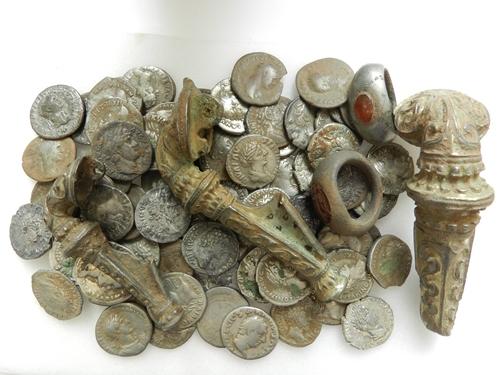A meeting of minds

In the current television series, Civilisations, David Olusoga has explored the idea that art and creativity are always on the frontline when cultures meet. Olusoga observed that through history encounters between different peoples have been be for many reasons, and have resulted in peaceful exchange or violent clashes.
 Romano-British Wirral brooch
In north west England the arrival of Roman legions elicited different responses in tribes in the region. The Cornovii, in the Welsh borders and Wirral, submitted to Roman rule. The Brigantes in north west England, signed a treaty with the Romans, but not all tribespeople agreed, and some of them rebelled and fought against Roman control. While the Ordovices in north Wales, were hostile to the Romans.
Some finds currently on display at the Museum of Liverpool bear witness to the mixing of ideas between Romans and the people they encountered in this region. In the History Detectives gallery's Timeline there are examples of Wirral brooches, a form of Roman-style bow brooch, with a distinctive chequered decoration, only found in this region, nowhere else in the Roman empire. This must represent a local craftsperson or people adapting styles they've seen introduced and adding their own creative flair.
Romano-British Wirral brooch
In north west England the arrival of Roman legions elicited different responses in tribes in the region. The Cornovii, in the Welsh borders and Wirral, submitted to Roman rule. The Brigantes in north west England, signed a treaty with the Romans, but not all tribespeople agreed, and some of them rebelled and fought against Roman control. While the Ordovices in north Wales, were hostile to the Romans.
Some finds currently on display at the Museum of Liverpool bear witness to the mixing of ideas between Romans and the people they encountered in this region. In the History Detectives gallery's Timeline there are examples of Wirral brooches, a form of Roman-style bow brooch, with a distinctive chequered decoration, only found in this region, nowhere else in the Roman empire. This must represent a local craftsperson or people adapting styles they've seen introduced and adding their own creative flair.
 Stamped tile excavated in Tarbock. Made in AD 167 for the Roman legionary fortress in Chester.
Similarly, a tile on display in the Timeline demonstrates the strong links between 'Britons' and Romans. A tile, made in a settlement which had been in existence since well before the Roman invasion, is marked with the stamp of the 20th Legion. This tile was presumably therefore made by indigenous people for the a Roman army building or repairing their fort in Chester.
Stamped tile excavated in Tarbock. Made in AD 167 for the Roman legionary fortress in Chester.
Similarly, a tile on display in the Timeline demonstrates the strong links between 'Britons' and Romans. A tile, made in a settlement which had been in existence since well before the Roman invasion, is marked with the stamp of the 20th Legion. This tile was presumably therefore made by indigenous people for the a Roman army building or repairing their fort in Chester.
 The Knutsford Hoard, buried in the AD190s
The Knutsford Hoard, on display at Museum of Liverpool until late April, includes three brooches. These beautiful objects are made from silver, bearing intricate decoration created through 'lost wax' casting. The swirls and spirals are picked out by parcel gilding, recessed areas filled with gold to contrast with the silver. These brooches are in the shape of Roman trumpet brooches, a form found across the empire. However, the decoration would have appeared quite traditional by the time these objects were buried in the late 2nd century AD, drawing on pre-Roman Iron Age styles. One theory about these objects is that they, and the wealth of coins buried with them were the wealth of a local person, possibly someone who had built wealth through the salt trade. Perhaps such individuals wanted to simultaneously show their Roman fashionability and their older roots, referring back to art seen across Iron Age Europe around a hundred years earlier.
Mixing and merging of cultures is an ever present part of our world throughout history, and objects which survive in the archaeological record relate stories of the ways in which people have met, traded, shared, exchanged ideas, amalgamated styles and influenced one-another.
The Knutsford Hoard, buried in the AD190s
The Knutsford Hoard, on display at Museum of Liverpool until late April, includes three brooches. These beautiful objects are made from silver, bearing intricate decoration created through 'lost wax' casting. The swirls and spirals are picked out by parcel gilding, recessed areas filled with gold to contrast with the silver. These brooches are in the shape of Roman trumpet brooches, a form found across the empire. However, the decoration would have appeared quite traditional by the time these objects were buried in the late 2nd century AD, drawing on pre-Roman Iron Age styles. One theory about these objects is that they, and the wealth of coins buried with them were the wealth of a local person, possibly someone who had built wealth through the salt trade. Perhaps such individuals wanted to simultaneously show their Roman fashionability and their older roots, referring back to art seen across Iron Age Europe around a hundred years earlier.
Mixing and merging of cultures is an ever present part of our world throughout history, and objects which survive in the archaeological record relate stories of the ways in which people have met, traded, shared, exchanged ideas, amalgamated styles and influenced one-another.
